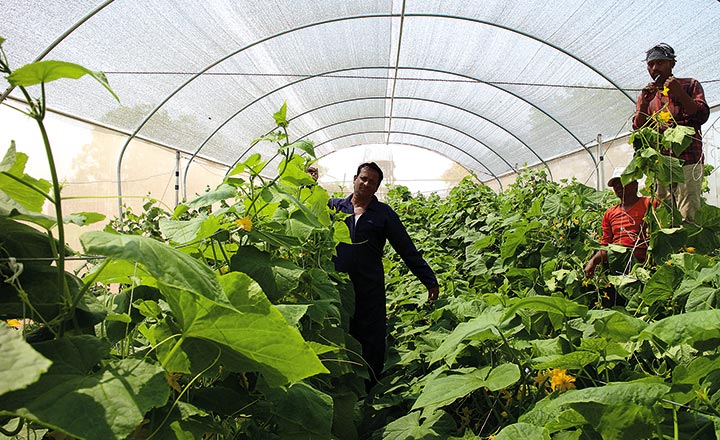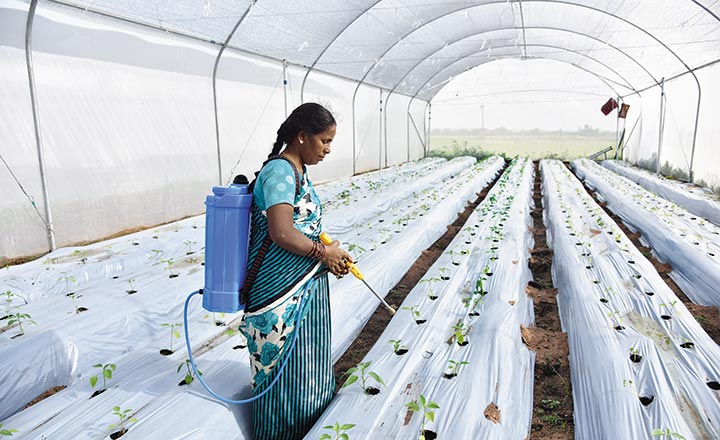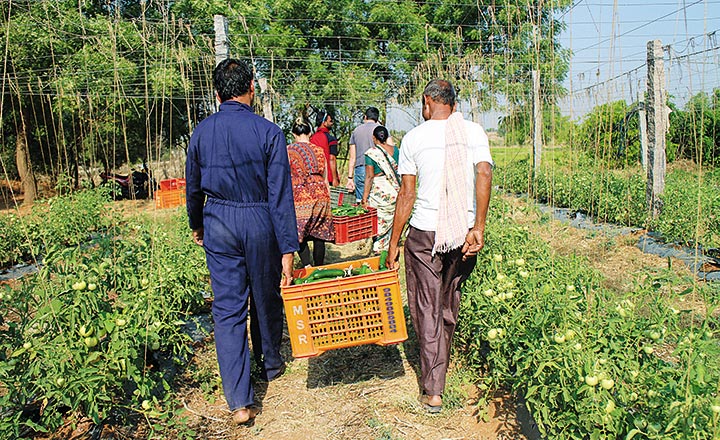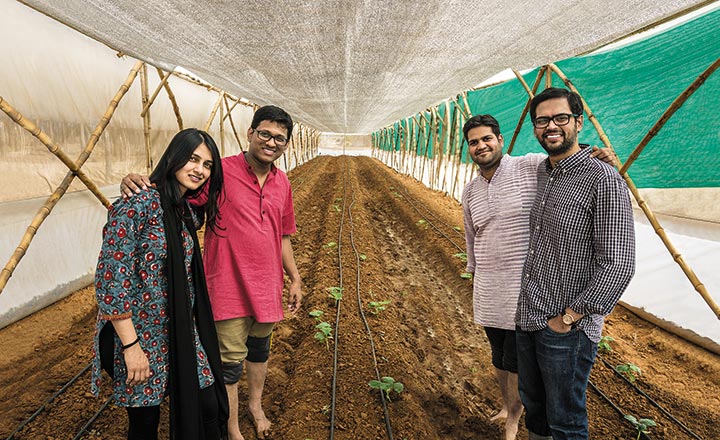The chirping of birds and tracts of agricultural land make for a pretty sight in Laxmapur village which is 45 km away from the hustle-bustle of Hyderabad. Appala Venkatesh gently sits on the grass with his wife. The 45-year-old, who has a one-acre plot, has been a farmer for as long as he can remember. Of the acre that he owns, one half went into paddy cultivation — a big crop in this part of the country — and the other in the cultivation of vegetables such as tomato and bhindi (okra).
Life had been a little harsh on Venkatesh. Pests coupled with a serious paucity of water were proving to be a nightmare. His total income from dairy and agriculture fetched him around Rs.85,000 each year. Of this, Rs.35,000 agri income was under threat. “The ground water was drying up and I did not know what to do,” he says.
“This February, however, things changed for the better,” says Venkatesh, pointing to the greenhouse. The large structure, resembling a tent, sits on 200 sq mt (or about 2,150 sq ft) of land and is covered from all sides to prevent pests and protect crops from excessive heat or unseasonal rainfall.
“We started cultivating cucumbers in mid-February and that lasted till May. We will now cultivate capsicum,” says Venkatesh with a smile. Over a three-month period, there was as much as 1,700 kg of the crop that came his way. That translated to an income of about Rs.6,000 each month after meeting all expenses.

He has managed to do all this with the help of Kheyti, a startup offering low-cost farming solutions to help farmers increase their yield and predictability of their produce. Started by Kaushik K, Sathya Raghu, Saumya and Ayush Sharma — all hailing from diverse backgrounds, Kheyti has installed 50 greenhouse-in-a-box structures in Laxmapur and its adjoining villages. “We will have a total of 150 structures by the end of this year and 500 by the end of the next,” says an ambitious Kaushik.
Going green
To be fair, the concept of a greenhouse is not new and has been around for decades in large parts of the world. For the people at Kheyti, a name derived from the Hindi word for farming, the task was to work around key issues such as size and affordability. The traditional and well-established model was of a greenhouse structure occupying as much as an acre and costing about Rs.30-40 lakh, which was out of reach for most small and marginal farmers. After spending Rs.65 lakh over prototyping for nearly a year, Kheyti finally came up with a greenhouse structure. But some more iterations were in store. Kheyti first came up with a 500 sq mt unit that could give farmers an income of Rs.10,000, but the costs were still high. The team went back to the drawing board again. The greenhouse had to be finally pruned to 200 sq mt, or just one-sixteenth of an acre, if it had to come within the reach of small farmers. They managed to bring down the size with the help of computer-aided design and the greenhouse-in-a-box now promised to generate a minimum of Rs.5,000 a month.
Rajeeb Roy, MD, Agriplast Tech, the company that manufactures Kheyti’s greenhouses, says that the brief was to “do it small.” The cost factor was definitely a constraint for him. “We had the design for a large structure. A basic concept was ready in less than a week,” he recalls. According to him, 98% of cultivation in India is done in the open field. “Only 2% is in the form of protected farming, and that is where the big opportunity exists.”

With the structure ready, Kheyti could reach out to farmers by joining hands with farmer producer organisations. But to begin with, the choice of Telangana was logical since three of the four co-founders came from Hyderabad, and all of them had a rural or agricultural background.
The idea of Kheyti had germinated in the process of conversing with over 200 farmers across Telangana and Maharashtra in early 2015. The team realised that getting it right on just the technology aspect was not good enough. The yields were impacted due to several reasons such as excess heat, increase in pests and decrease in water levels. In reality, they were victims of climate change, something they had not figured out. The team realised that one of the main reasons for yields being low was open cultivation. The crops needed a protective cover so as not to let the heat or insects impact them directly. After 9-12 months of extensive research, the team at Kheyti developed a low-cost modular greenhouse-in-a-box. Its two layers of shade netting on the top would make the greenhouse cooler by 5 -8 °C, and the insect netting would keep almost 90% of the bugs away. It takes about three to four days to put the structure in place.
One of the co-founders, Raghu, a chartered account by qualification, realised that apart from greenhouses, the company also had to be an end-to-end player. “Farmers told us that they had no access to the right kind of seeds, financing, training or markets. It was clear that we had to be system integrators and that took a year,” he says. To get better at all this, Kheyti worked closely with institutes such as ICRISAT in Hyderabad for crop research, Israel’s Netafim for drip irrigation, and, of course, with Agriplast to build the structures.
As a result of all this, Kheyti today is not just able to provide seeds and fertilisers to farmers but also connect them to larger fruit-and-vegetable retail chains. It has struck the right chord, and a company such as Big Basket is not oblivious to the opportunity. According to Aveen Gurram, category manager (fruits & vegetables), Big Basket, there is an assurance and comfort on quality and the ability to reach out directly to the farmers. “Since the mechanism is a lot more organised, the middlemen have largely been eliminated in these villages,” he says.
For the farmer, there is a significant reason to be part of the story. Greenhouse occupies a fraction of his land, uses 90% less water, thanks to drip irrigation, but promises a significant improvement in yields. Venkatesh confirms that what he grows on 200 sq mt is what he would grow in 1,500 sq mt. In other words, this is a yield that is at least seven times more. To be sure, greenhouses have always consumed less water and offered more yield say about 4-5 times. But continuous monitoring through daily visits by the Kheyti team fetches much higher yields for farmers. One of the biggest challenges that small and marginal farmers face is that their income is often unpredictable and sometimes barely enough to cover their expenses. So, having a greenhouse that can grow vegetables and fruits and occupies only 2% of their land, gives them a dependable source of income even if 98% of the land is exposed to the vagaries of weather and pest attacks.
Money talks
For the farmer, the total outgo to install the greenhouse is Rs.1.6 lakh. Given his limited means, coughing up the entire amount was impossible. The farmer would make a down payment of Rs.30,000 and Kheyti would help in arranging finance for the rest. The funding comes from banks or NBFCs. So, Kheyti reached out to KBS Bank (Krishna Bhima Samruddhi Bank), a local entity, to fund the first 15 farmers. But there was a serious issue. Sharma says the bank asked for collaterals, and had fairly strict KYC (know your client) requirements. Since there was nothing to show, the deal never went through.
With its back to the wall, Kheyti had to fund the 15 greenhouses by itself. Using the data, Kheyti reached out to Samunnati Financial Intermediation & Services, a Chennai-based NBFC, specialising in agri-asset financing. They agreed to an uncollateralised loan at a rate of 22%. Says Anil Kumar, MD at Samunnati, “We liked the fact that the promoters at Kheyti took responsibility for market linkages. As lenders, it assured us about the viability of the model.” This took care of the next 35 greenhouses.

However, the breakthrough moment for Kheyti came when they closed a deal with Bank of Baroda. The bank will now offer loans at a rate of 8.65% to farmers, which will lead to a saving of Rs.14,000 per year. “Further, the collateral will be the greenhouse and not the land,” Kaushik explains.
For an average farmer, around two-thirds or Rs.20,000 for the down payment comes from his savings, which takes care of a large part of the initial requirement. Typically, he borrows Rs.10,000 from the village folk or moneylenders, who charges close to 2% per month, which in a good harvest can be repaid in three to four months. “The farmer eventually comes around when he realises that this [arrangement] diversifies his income and makes this portion one that is assured,” says Sharma. The Rs.30,000 is spent on inputs (fertilisers and seeds), irrigation and installation charges.
Seeds of change
In all, 50 greenhouses have been installed so far, with another 100 expected to come up by the end of 2017 in Telangana.
These are still early days and the road ahead is fraught with challenges. Saumya, another co-founder, who chucked a career in investment banking when the social enterprise bug bit her, is forthright when she speaks of ensuring that farmers will need to replicate this across seasons and different vegetables. “On the product side, it takes a lot for a small farmer to pay the Rs.30,000. As scale increases, we will have to bring down manufacturing costs to pass on the benefit,” she says.
The co-founders on their part have put in Rs.17 lakh from their savings and managed to raise Rs.2.5 crore from foundations in the US, Sweden and the UK. Lennart Grebelius, chair, Satila Foundation, which is one of Kheyti’s Swedish funders, says, “In the controlled environment of greenhouses, yields can be high in spite of unpredictable weather conditions. The increase in yield in relation to labour and capital invested is crucial. Once that equation works out fine, we have the foundation for a large scale-up.”
In FY17, Kheyti clocked revenue of Rs.80 lakh and expects to hit Rs.2.4 crore this year as it gains acceptance from farmers. Raghu says 14 of the first lot of 15 farmers are now open to having another greenhouse. While that is some reason to be enthused, there is still a lot more to be done. “The problems are deep-rooted and even a small change can make a huge difference. While we speak of 100 million farmers, making a difference even to a million is huge,” Saumya sums up. If that indeed happens, Kheyti would truly be running a high-yield business.











